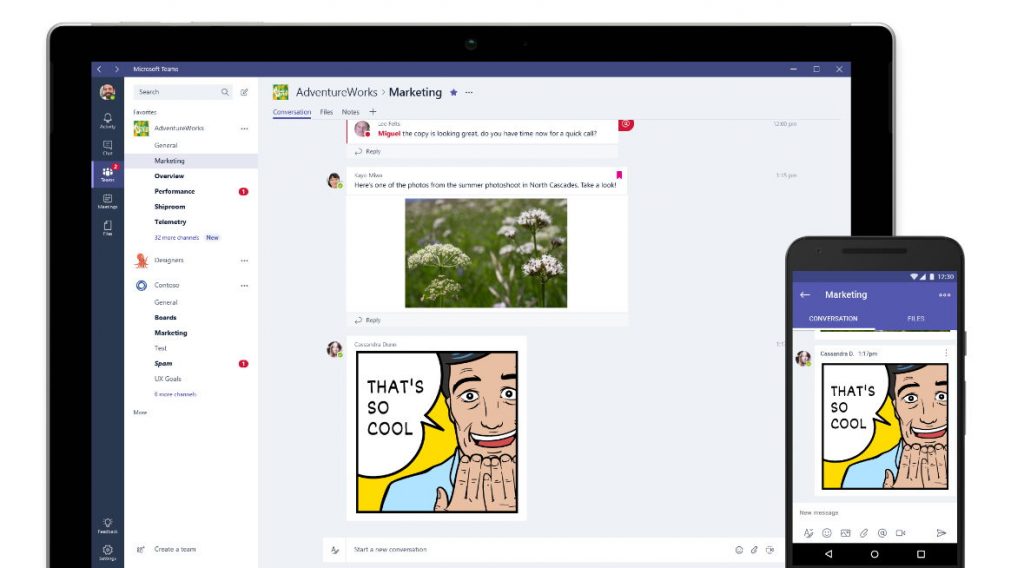When your product announcement is a special media event featuring a keynote speech by Microsoft CEO Satya Nadella, and on the day of preview release, you launch simultaneously with full-featured apps for Windows, Mac, iOS, Android and the Web, well, to paraphrase Ron Burgundy, you’re kind of a big deal.
Microsoft Teams is that product, introduced in preview on November 2nd, and hailed by pundits as a “Slack killer.” Slack Technologies themselves even took out a full-page New York Times ad “welcoming” Microsoft to their turf.
Slack Killer? Or something else in mind?
While this makes for a good story and high drama in the tech world, I think Microsoft has something bigger in mind than killing Slack. I can’t pretend to know their motivations, but I don’t think they fear Slack, or that they even want it “killed”, and I don’t guess that was their intention with Teams. After all, Microsoft has an estimated 85 million business users of Office 365, to Slack’s 4 million users, two-thirds of whom pay nothing for the free version of Slack.
No, what I think Microsoft is after goes deeper. Exchange Online (email) is the gateway drug to the cloud, and I suspect many of those Office 365 subscribers use only email today (though Microsoft doesn’t break that out). They are pushing hard to drive engagement in the other parts of Office 365 beyond email, because those Office 365 subscriptions get more “sticky” as more business functions start to take advantage of O365 features.

Office 365 built-in is the Microsoft Teams Differentiator
That’s where Teams comes in. Microsoft is taking a Slack-like collaboration platform, making it part of your Office 365 subscription, and dropping it into the middle of a rich Office 365 ecosystem. What I mean is that, although Teams supports 3rd-party integrations as Slack does, many of the add-ons and extensions that enrich the platform are already included in Office 365 subscriptions, not as mere add-ons but as full-featured and mature core products. For example, if you send a file in a chat session with your team, you’ll find the file is automatically copied into a SharePoint Team site that was created for your team. Browse those files without leaving Teams, then click on one of them, and it opens in an Excel viewer, without leaving Teams. While viewing the file, click one button to start a conversation with your team about the document, right in the side panel next to the document. While chatting, start a video conference, again without leaving Teams, using the Skype engine, another part of Office 365. Want to schedule a meeting for later? Click the side panel to see your schedule, brought in live from your Outlook calendar, and click a button to send a meeting request…again without leaving Teams.
The list goes on…a Notes tab to pin important information and share content in a sticky place where the whole team can access it, is under the hood, a OneNote notebook that was automatically created for your team. Those familiar with Outlook Groups will find that their Groups and Teams are joined behind the scenes, and have the same membership and a common file sharing (SharePoint) location. Delve makes an appearance, and you can be forgiven for not knowing the significance of that, but a feature that shows me any file anywhere in Office 365 that I’ve opened in recent days is the tip of the iceberg of what else will be coming.
With Teams, Microsoft has created a virtual workspace that is a hub into the rest of Office 365. This rich experience for the user will fully immerse them in Office 365 without the user having to leave the Teams app. It is a stroke of genius, because of course, that will make the Office 365 subscription essential to the organization and very hard to give up.
We’ve been using Teams internally for several weeks now. We’re excited about its possibilities, partly for how we’re going to use it, but not only that. We work with many of our clients consulting and educating theooow to make use of Office 365 in their business. We think Microsoft Teams has great potential to shorten the learning curve for companies who want to take advantage of Office 365’s capabilities beyond email. We’ve seen how simple things, like a shared file or notebook, or internal chat, can have a big impact on employee engagement and productivity. Microsoft Teams, looked at from that standpohe potential to be truly transforming to organizations.
Microsoft Teams is in preview now, with general release targeted for Q1 2017. If you’d like to learn more about it, or explore whether it makes sense for your organization, drop me a note at [email protected]


You must be logged in to post a comment.